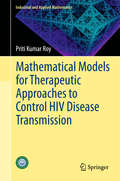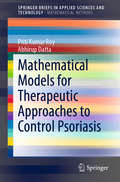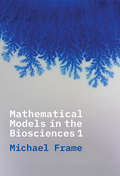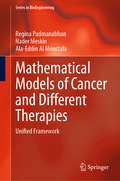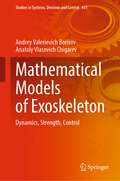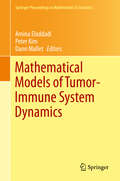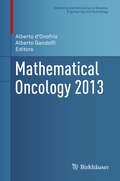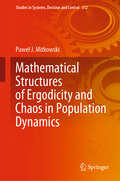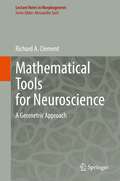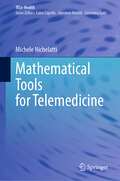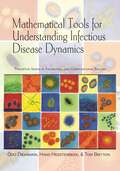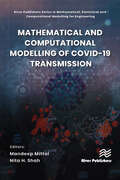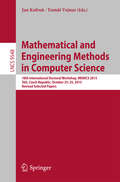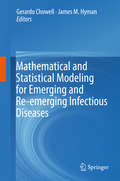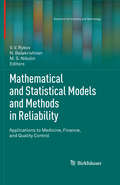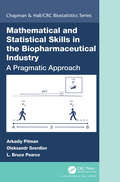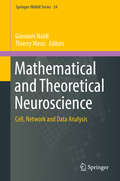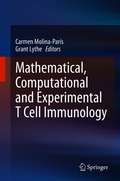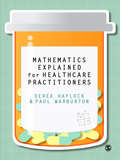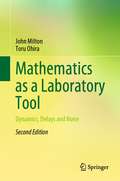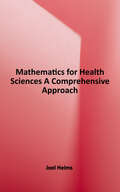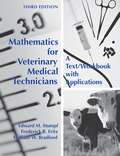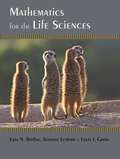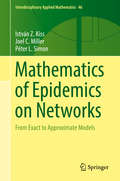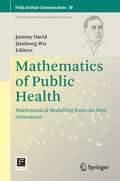- Table View
- List View
Mathematical Models for Therapeutic Approaches to Control HIV Disease Transmission
by Priti Kumar RoyThe book discusses different therapeutic approaches based on different mathematical models to control the HIV/AIDS disease transmission. It uses clinical data, collected from different cited sources, to formulate the deterministic as well as stochastic mathematical models of HIV/AIDS. It provides complementary approaches, from deterministic and stochastic points of view, to optimal control strategy with perfect drug adherence and also tries to seek viewpoints of the same issue from different angles with various mathematical models to computer simulations. The book presents essential methods and techniques for students who are interested in designing epidemiological models on HIV/AIDS. It also guides research scientists, working in the periphery of mathematical modeling, and helps them to explore a hypothetical method by examining its consequences in the form of a mathematical modelling and making some scientific predictions. The model equations, mathematical analysis and several numerical simulations that are presented in the book would serve to reveal the consequences of the logical structure of the disease transmission, quantitatively as well as qualitatively. One of the chapters introduces the optimal control approach towards the mathematical models, describing the optimal drug dosage process that is discussed with the basic deterministic models dealing with stability analysis. Another one chapter deals with the mathematical analysis for the perfect drug adherence for different drug dynamics during the treatment management. The last chapter of the book consists the stochastic approach to the disease dynamics on HIV/AIDS. This method helps to move the disease HIV/AIDS to extinction as the time to increase. This book will appeal to undergraduate and postgraduate students, as well as researchers, who are studying and working in the field of bio-mathematical modelling on infectious diseases, applied mathematics, health informatics, applied statistics and qualitative public health, etc. Social workers, who are working in the field of HIV, will also find the book useful for complements.
Mathematical Models for Therapeutic Approaches to Control Psoriasis (SpringerBriefs in Applied Sciences and Technology)
by Priti Kumar Roy Abhirup DattaThis book discusses several mathematical models highlighting the disease dynamics of psoriasis and its control. It explains the control of keratinocyte concentration through a negative feedback mechanism and the effect of including a realistic time delay in that system. The effect of cytokine release is described in a mathematical model of psoriasis and further elucidated in two different mathematical pathways: the ordinary differential equation model system, and the fractional-order differential equation model system. The book also identifies the role of CD8+ T-cells in psoriasis by investigating the interaction between dendritic cells and CD8+ T-cells. Presenting an approach to control the fractional-order system to prevent excess production of keratinocyte cell population, the book is intended for researchers and scientists in the field of applied mathematics, health informatics, applied statistics and qualitative public health, as well as bio-mathematicians interested in the mathematical modeling of autoimmune diseases like psoriasis.
Mathematical Models in the Biosciences I
by Michael FrameAn award-winning professor’s introduction to essential concepts of calculus and mathematical modeling for students in the biosciences This is the first of a two-part series exploring essential concepts of calculus in the context of biological systems. Michael Frame covers essential ideas and theories of basic calculus and probability while providing examples of how they apply to subjects like chemotherapy and tumor growth, chemical diffusion, allometric scaling, predator-prey relations, and nerve impulses. Based on the author’s calculus class at Yale University, the book makes concepts of calculus more relatable for science majors and premedical students.
Mathematical Models of Cancer and Different Therapies: Unified Framework (Series in BioEngineering)
by Regina Padmanabhan Nader Meskin Ala-Eddin Al MoustafaThis book provides a unified framework for various currently available mathematical models that are used to analyze progression and regression in cancer development, and to predict its dynamics with respect to therapeutic interventions. Accurate and reliable model representations of cancer dynamics are milestones in the field of cancer research. Mathematical modeling approaches are becoming increasingly common in cancer research, as these quantitative approaches can help to validate hypotheses concerning cancer dynamics and thus elucidate the complexly interlaced mechanisms involved. Even though the related conceptual and technical information is growing at an exponential rate, the application of said information and realization of useful healthcare devices are lagging behind.In order to remedy this discrepancy, more interdisciplinary research works and course curricula need to be introduced in academic, industrial, and clinical organizations alike. To that end, this book reformulates most of the existing mathematical models as special cases of a general model, allowing readers to easily get an overall idea of cancer dynamics and its modeling. Moreover, the book will help bridge the gap between biologists and engineers, as it brings together cancer dynamics, the main steps involved in mathematical modeling, and control strategies developed for cancer management. This also allows readers in both medical and engineering fields to compare and contrast all the therapy-based models developed to date using a single source, and to identify unexplored research directions.
Mathematical Models of Exoskeleton: Dynamics, Strength, Control (Studies in Systems, Decision and Control #431)
by Andrey Valerievich Borisov Anatoly Vlasovich ChigarevThis book presents the current state of the problem of describing the musculoskeletal system of a person. Models of the destruction of the endoskeleton and the restoration of its functions using exoskeleton are presented. A description is given of new approaches to modeling based on the use of weightless rods of variable length with concentrated masses. The practical application to the tasks of numerical simulation of the movements of the musculoskeletal system of a person is described. Exoskeleton models with variable-length units based on absolutely hard sections and sections that change their telescopic type length have been developed.The book is intended for specialists in the field of theoretical mechanics, biomechanics, robotics and related fields. The book will be useful to teachers, as well as graduate students, undergraduates and senior students of higher educational institutions, whose research interests lie in the modeling of anthropomorphic biomechanical systems.
Mathematical Models of Tumor-Immune System Dynamics
by Peter Kim Amina Eladdadi Dann MalletThis collection of papers offers a broad synopsis of state-of-the-art mathematical methods used in modeling the interaction between tumors and the immune system. These papers were presented at the four-day workshop on Mathematical Models of Tumor-Immune System Dynamics held in Sydney, Australia from January 7th to January 10th, 2013. The workshop brought together applied mathematicians, biologists, and clinicians actively working in the field of cancer immunology to share their current research and to increase awareness of the innovative mathematical tools that are applicable to the growing field of cancer immunology. Recent progress in cancer immunology and advances in immunotherapy suggest that the immune system plays a fundamental role in host defense against tumors and could be utilized to prevent or cure cancer. Although theoretical and experimental studies of tumor-immune system dynamics have a long history, there are still many unanswered questions about the mechanisms that govern the interaction between the immune system and a growing tumor. The multidimensional nature of these complex interactions requires a cross-disciplinary approach to capture more realistic dynamics of the essential biology. The papers presented in this volume explore these issues and the results will be of interest to graduate students and researchers in a variety of fields within mathematical and biological sciences.
Mathematical Oncology 2013
by Alberto D'Onofrio Alberto GandolfiWith chapters on free boundaries, constitutive equations, stochastic dynamics, nonlinear diffusion-consumption, structured populations, and applications of optimal control theory, this volume presents the most significant recent results in the field of mathematical oncology. It highlights the work of world-class research teams, and explores how different researchers approach the same problem in various ways. Tumors are complex entities that present numerous challenges to the mathematical modeler. First and foremost, they grow. Thus their spatial mean field description involves a free boundary problem. Second, their interiors should be modeled as nontrivial porous media using constitutive equations. Third, at the end of anti-cancer therapy, a small number of malignant cells remain, making the post-treatment dynamics inherently stochastic. Fourth, the growth parameters of macroscopic tumors are non-constant, as are the parameters of anti-tumor therapies. Changes in these parameters may induce phenomena that are mathematically equivalent to phase transitions. Fifth, tumor vascular growth is random and self-similar. Finally, the drugs used in chemotherapy diffuse and are taken up by the cells in nonlinear ways. Mathematical Oncology 2013 will appeal to graduate students and researchers in biomathematics, computational and theoretical biology, biophysics, and bioengineering.
Mathematical Structures of Ergodicity and Chaos in Population Dynamics (Studies in Systems, Decision and Control #312)
by Paweł J. MitkowskiThis book concerns issues related to biomathematics, medicine, or cybernetics as practiced by engineers. Considered population dynamics models are still in the interest of researchers, and even this interest is increasing, especially now in the time of SARS-CoV-2 coronavirus pandemic, when models are intensively studied in order to help predict its behaviour within human population. The structures of population dynamics models and practical methods of finding their solutions are discussed. Finally, the hypothesis of the existence of non-trivial ergodic properties of the model of erythropoietic response dynamics formulated by A. Lasota in the form of delay differential equation with unimodal feedback is analysed. The research can be compared with actual medical data, as well as shows that the structures of population models can reflect the dynamic structures of reality.
Mathematical Tools for Neuroscience: A Geometric Approach (Lecture Notes in Morphogenesis)
by Richard A. ClementThis book provides a brief but accessible introduction to a set of related, mathematical ideas that have proved useful in understanding the brain and behaviour. If you record the eye movements of a group of people watching a riverside scene then some will look at the river, some will look at the barge by the side of the river, some will look at the people on the bridge, and so on, but if a duck takes off then everybody will look at it. How come the brain is so adept at processing such biological objects? In this book it is shown that brains are especially suited to exploiting the geometric properties of such objects. Central to the geometric approach is the concept of a manifold, which extends the idea of a surface to many dimensions. The manifold can be specified by collections of n-dimensional data points or by the paths of a system through state space. Just as tangent planes can be used to analyse the local linear behaviour of points on a surface, so the extension to tangent spaces can be used to investigate the local linear behaviour of manifolds. The majority of the geometric techniques introduced are all about how to do things with tangent spaces.Examples of the geometric approach to neuroscience include the analysis of colour and spatial vision measurements and the control of eye and arm movements. Additional examples are used to extend the applications of the approach and to show that it leads to new techniques for investigating neural systems. An advantage of following a geometric approach is that it is often possible to illustrate the concepts visually and all the descriptions of the examples are complemented by comprehensively captioned diagrams.The book is intended for a reader with an interest in neuroscience who may have been introduced to calculus in the past but is not aware of the many insights obtained by a geometric approach to the brain. Appendices contain brief reviews of the required background knowledge in neuroscience and calculus.
Mathematical Tools for Telemedicine (TELe-Health)
by Michele NichelattiThis book is intended for professionals who must deal with telemedicine having little or no knowledge of matrix algebra and matrix calculus, and little or no knowledge of higher mathematics with special reference to differential equations: no other books cover these topics starting from scratch. It would therefore fill the gap existing between very simple and elementary textbooks and much more complicated ones, mainly adopting mathematical and on engineering approaches. Aims and objectives of this volume are to provide non-mathematicians and non-physicists with an almost complete coverage of the topic, from calculus and linear algebra to matrix derivatives, hat matrices, and regression models, as well as to give basic information about the description of a system by means of differential equations, which will be useful for a deeper understanding of telemedicine. The book is mainly addressing postgraduate students in medicine, biology, biostatistics, but it would also be a very useful tool researchers in other fields of a medical/biomedical curriculum.
Mathematical Tools for Understanding Infectious Disease Dynamics (Princeton Series in Theoretical and Computational Biology #7)
by Hans Heesterbeek Odo Diekmann Tom BrittonMathematical modeling is critical to our understanding of how infectious diseases spread at the individual and population levels. This book gives readers the necessary skills to correctly formulate and analyze mathematical models in infectious disease epidemiology, and is the first treatment of the subject to integrate deterministic and stochastic models and methods.Mathematical Tools for Understanding Infectious Disease Dynamics fully explains how to translate biological assumptions into mathematics to construct useful and consistent models, and how to use the biological interpretation and mathematical reasoning to analyze these models. It shows how to relate models to data through statistical inference, and how to gain important insights into infectious disease dynamics by translating mathematical results back to biology. This comprehensive and accessible book also features numerous detailed exercises throughout; full elaborations to all exercises are provided.Covers the latest research in mathematical modeling of infectious disease epidemiologyIntegrates deterministic and stochastic approachesTeaches skills in model construction, analysis, inference, and interpretationFeatures numerous exercises and their detailed elaborationsMotivated by real-world applications throughout
Mathematical and Computational Modelling of Covid-19 Transmission (River Publishers Series in Mathematical, Statistical and Computational Modelling for Engineering)
by Nita H. ShahInfectious diseases are leading threats and are of highest risk to the human population globally. Over the last two years, we saw the transmission of Covid-19. Millions of people died or were forced to live with a disability. Mathematical models are effective tools that enable analysis of relevant information, simulate the related process and evaluate beneficial results. They can help to make rational decisions to lead toward a healthy society. Formulation of mathematical models for a pollution-free environment is also very important for society. To determine the system which can be modelled, we need to formulate the basic context of the model underlying some necessary assumptions. This describes our beliefs in terms of the mathematical language of how the world functions. This book addresses issues during the Covid phase and post-Covid phase. It analyzes transmission, impact of coinfections, and vaccination as a control or to decrease the intensity of infection. It also talks about the violence and unemployment problems occurring during the post-Covid period. This book will help societal stakeholders to resume normality slowly and steadily.
Mathematical and Engineering Methods in Computer Science
by Jan Kofroň Tomáš VojnarThis volume contains the post-conference proceedings of the 10th Doctoral Workshop on Mathematical and Engineering Methods in Computer Science, MEMICS 2015, held in Telč, Czech Republic, in October 2015. The 10 thoroughly revised full papers were carefully selected out of 25 submissions and are presented together with 3 invited papers. The topics covered include: security and safety, bioinformatics, recommender systems, high-performance and cloud computing, and non-traditional computational models (quantum computing, etc. ).
Mathematical and Statistical Modeling for Emerging and Re-emerging Infectious Diseases
by Gerardo Chowell James M. HymanThe contributions by epidemic modeling experts describe how mathematical models and statistical forecasting are created to capture the most important aspects of an emerging epidemic. Readers will discover a broad range of approaches to address questions, such as Can we control Ebola via ring vaccination strategies? How quickly should we detect Ebola cases to ensure epidemic control? What is the likelihood that an Ebola epidemic in West Africa leads to secondary outbreaks in other parts of the world? When does it matter to incorporate the role of disease-induced mortality on epidemic models? What is the role of behavior changes on Ebola dynamics? How can we better understand the control of cholera or Ebola using optimal control theory? How should a population be structured in order to mimic the transmission dynamics of diseases such as chlamydia, Ebola, or cholera? How can we objectively determine the end of an epidemic? How can we use metapopulation models to understand the role of movement restrictions and migration patterns on the spread of infectious diseases? How can we capture the impact of household transmission using compartmental epidemic models? How could behavior-dependent vaccination affect the dynamical outcomes of epidemic models? The derivation and analysis of the mathematical models addressing these questions provides a wide-ranging overview of the new approaches being created to better forecast and mitigate emerging epidemics. This book will be of interest to researchers in the field of mathematical epidemiology, as well as public health workers.
Mathematical and Statistical Models and Methods in Reliability
by N. Balakrishnan M. S. Nikulin V. V. RykovThe book is a selection of invited chapters, all of which deal with various aspects of mathematical and statistical models and methods in reliability. Written by renowned experts in the field of reliability, the contributions cover a wide range of applications, reflecting recent developments in areas such as survival analysis, aging, lifetime data analysis, artificial intelligence, medicine, carcinogenesis studies, nuclear power, financial modeling, aircraft engineering, quality control, and transportation. Mathematical and Statistical Models and Methods in Reliability is an excellent reference text for researchers and practitioners in applied probability and statistics, industrial statistics, engineering, medicine, finance, transportation, the oil and gas industry, and artificial intelligence.
Mathematical and Statistical Skills in the Biopharmaceutical Industry: A Pragmatic Approach (Chapman & Hall/CRC Biostatistics Series)
by Arkadiy PitmanMathematical and Statistical Skills in the Biopharmaceutical Industry: A Pragmatic Approach describes a philosophy of efficient problem solving showcased using examples pertinent to the biostatistics function in clinical drug development. It was written to share a quintessence of the authors’ experiences acquired during many years of relevant work in the biopharmaceutical industry. The book will be useful will be useful for biopharmaceutical industry statisticians at different seniority levels and for graduate students who consider a biostatistics-related career in this industry. Features: Describes a system of principles for pragmatic problem solving in clinical drug development. Discusses differences in the work of a biostatistician in small pharma and big pharma. Explains the importance/relevance of statistical programming and data management for biostatistics and necessity for integration on various levels. Describes some useful statistical background that can be capitalized upon in the drug development enterprise. Explains some hot topics and current trends in biostatistics in simple, non-technical terms. Discusses incompleteness of any system of standard operating procedures, rules and regulations. Provides a classification of scoring systems and proposes a novel approach for evaluation of the safety outcome for a completed randomized clinical trial. Presents applications of the problem solving philosophy in a highly problematic transfusion field where many investigational compounds have failed. Discusses realistic planning of open-ended projects.
Mathematical and Theoretical Neuroscience: Cell, Network And Data Analysis (Springer INdAM #24)
by Giovanni Naldi Thierry NieusThis volume gathers contributions from theoretical, experimental and computational researchers who are working on various topics in theoretical/computational/mathematical neuroscience. The focus is on mathematical modeling, analytical and numerical topics, and statistical analysis in neuroscience with applications. The following subjects are considered: mathematical modelling in Neuroscience, analytical and numerical topics; statistical analysis in Neuroscience; Neural Networks; Theoretical Neuroscience. The book is addressed to researchers involved in mathematical models applied to neuroscience.
Mathematical, Computational and Experimental T Cell Immunology
by Carmen Molina-París Grant LytheMathematical, statistical, and computational methods enable multi-disciplinary approaches that catalyse discovery. Together with experimental methods, they identify key hypotheses, define measurable observables and reconcile disparate results. This volume collects a representative sample of studies in T cell immunology that illustrate the benefits of modelling-experimental collaborations and which have proven valuable or even ground-breaking. Studies include thymic selection, T cell repertoire diversity, T cell homeostasis in health and disease, T cell-mediated immune responses, T cell memory, T cell signalling and analysis of flow cytometry data sets. Contributing authors are leading scientists in the area of experimental, computational, and mathematical immunology. Each chapter includes state-of-the-art and pedagogical content, making this book accessible to readers with limited experience in T cell immunology and/or mathematical and computational modelling.
Mathematics Explained for Healthcare Practitioners
by Derek Haylock Paul WarburtonIf you find mathematics a struggle, or if mathematics makes you panic - whether you′re a student preparing for a calculations test, or a qualified healthcare professional - this is the book for you. Its focus is first and foremost on helping you develop a proper and lasting understanding of mathematical concepts and processes in a healthcare context, with an emphasis on developing mental strategies to reinforce your feeling for number and numerical relationships. Clear, accessible chapters take you step-by-step through specific sets of objectives, and once you feel you have fully mastered a particular mathematical process, you′re encouraged to practise your skills through a range of practical examples. Each chapter also contains a ′Spot the Errors′ feature designed to reflect the busy, pressurised healthcare environment. Written by Derek Haylock, a best-selling mathematics educator, and Paul Warburton, co-ordinator of the Non-Medical Prescribing programme at Edge Hill University, the book is directly linked to the NMC′s competencies and will give you the confidence to perform the safe, error-free calculations required of all healthcare professionals.
Mathematics as a Laboratory Tool: Dynamics, Delays and Noise
by John Milton Toru OhiraThe second edition of Mathematics as a Laboratory Tool reflects the growing impact that computational science is having on the career choices made by undergraduate science and engineering students. The focus is on dynamics and the effects of time delays and stochastic perturbations (“noise”) on the regulation provided by feedback control systems. The concepts are illustrated with applications to gene regulatory networks, motor control, neuroscience and population biology. The presentation in the first edition has been extended to include discussions of neuronal excitability and bursting, multistability, microchaos, Bayesian inference, second-order delay differential equations, and the semi-discretization method for the numerical integration of delay differential equations. Every effort has been made to ensure that the material is accessible to those with a background in calculus. The text provides advanced mathematical concepts such as the Laplace and Fourier integral transforms in the form of Tools. Bayesian inference is introduced using a number of detective-type scenarios including the Monty Hall problem.
Mathematics for Health Sciences: A Comprehensive Approach
by Joel HelmsSelect topics according to your mathematical ability and chosen healthcare profession. Begin with a basic math review or move right to deeper concepts, including algebra and geometry, linear equations and graphing, dilutions, solutions, concentrations, dosage calculations, and more! Learn at your own pace with this easy-to-use math text specifically for the health sciences.
Mathematics for Veterinary Medical Technicians (Third Edition)
by Edward M. Stumpf Frederick R. Fritz William W. BradfordThe text provides a one-semester course in the basics of mathematics needed for Veterinary Technicians and Assistants.
Mathematics for the Life Sciences
by Louis J. Gross Suzanne Lenhart Erin N. BodineAn accessible undergraduate textbook on the essential math concepts used in the life sciencesThe life sciences deal with a vast array of problems at different spatial, temporal, and organizational scales. The mathematics necessary to describe, model, and analyze these problems is similarly diverse, incorporating quantitative techniques that are rarely taught in standard undergraduate courses. This textbook provides an accessible introduction to these critical mathematical concepts, linking them to biological observation and theory while also presenting the computational tools needed to address problems not readily investigated using mathematics alone.Proven in the classroom and requiring only a background in high school math, Mathematics for the Life Sciences doesn't just focus on calculus as do most other textbooks on the subject. It covers deterministic methods and those that incorporate uncertainty, problems in discrete and continuous time, probability, graphing and data analysis, matrix modeling, difference equations, differential equations, and much more. The book uses MATLAB throughout, explaining how to use it, write code, and connect models to data in examples chosen from across the life sciences.Provides undergraduate life science students with a succinct overview of major mathematical concepts that are essential for modern biologyCovers all the major quantitative concepts that national reports have identified as the ideal components of an entry-level course for life science studentsProvides good background for the MCAT, which now includes data-based and statistical reasoningExplicitly links data and math modelingIncludes end-of-chapter homework problems, end-of-unit student projects, and select answers to homework problemsUses MATLAB throughout, and MATLAB m-files with an R supplement are available onlinePrepares students to read with comprehension the growing quantitative literature across the life sciencesA solutions manual for professors and an illustration package is available
Mathematics of Epidemics on Networks
by István Z. Kiss Joel C. Miller Péter L. SimonThis textbook provides an exciting new addition to the area of network science featuring a stronger and more methodical link of models to their mathematical origin and explains how these relate to each other with special focus on epidemic spread on networks. The content of the book is at the interface of graph theory, stochastic processes and dynamical systems. The authors set out to make a significant contribution to closing the gap between model development and the supporting mathematics. This is done by: Summarising and presenting the state-of-the-art in modeling epidemics on networks with results and readily usable models signposted throughout the book; Presenting different mathematical approaches to formulate exact and solvable models; Identifying the concrete links between approximate models and their rigorous mathematical representation; Presenting a model hierarchy and clearly highlighting the links between model assumptions and model complexity; Providing a reference source for advanced undergraduate students, as well as doctoral students, postdoctoral researchers and academic experts who are engaged in modeling stochastic processes on networks; Providing software that can solve differential equation models or directly simulate epidemics on networks. Replete with numerous diagrams, examples, instructive exercises, and online access to simulation algorithms and readily usable code, this book will appeal to a wide spectrum of readers from different backgrounds and academic levels. Appropriate for students with or without a strong background in mathematics, this textbook can form the basis of an advanced undergraduate or graduate course in both mathematics and other departments alike.
Mathematics of Public Health: Mathematical Modelling from the Next Generation (Fields Institute Communications #88)
by Jianhong Wu Jummy DavidThis volume addresses SDG 3 from a mathematical standpoint, sharing novel perspectives of existing communicable disease modelling technologies of the next generation and disseminating new developments in modelling methodologies and simulation techniques. These methodologies are important for training and research in communicable diseases and can be applied to other threats to human health. The contributions contained in this collection/book cover a range of modelling techniques that have been and may be used to support decision-making on critical health related issues such as: Resource allocation Impact of climate change on communicable diseases Interaction of human behaviour change, and disease spread Disease outbreak trajectories projection Public health interventions evaluation Preparedness and mitigation of emerging and re-emerging infectious diseases outbreaks Development of vaccines and decisions around vaccine allocation and optimization The diseases and public health issues in this volume include, but are not limited to COVID-19, HIV, Influenza, antimicrobial resistance (AMR), the opioid epidemic, Lyme Disease, Zika, and Malaria. In addition, this volume compares compartmental models, agent-based models, machine learning and network. Readers have an opportunity to learn from the next generation perspective of evolving methodologies and algorithms in modelling infectious diseases, the mathematics behind them, the motivation for them, and some applications to supporting critical decisions on prevention and control of communicable diseases. This volume was compiled from the weekly seminar series organized by the Mathematics for Public Health (MfPH) Next Generation Network. This network brings together the next generation of modellers from across Canada and the world, developing the latest mathematical models, modeling methodologies, and analytical and simulation tools for communicable diseases of global public health concerns. The weekly seminar series provides a unique forum for this network and their invited guest speakers to share their perspectives on the status and future directions of mathematics of public health.
